One of the enduring qualities of the 1986 Oz-punk classic Dogs In Space has been its consistent ability to surprise – not least of all its director. “I can’t understand it,” laughs Richard Lowenstein. “It looks and feels as if I shot it yesterday, and I honestly can’t answer why that is. My other films aren’t like that! It’s definitely taken on a life of its own.”
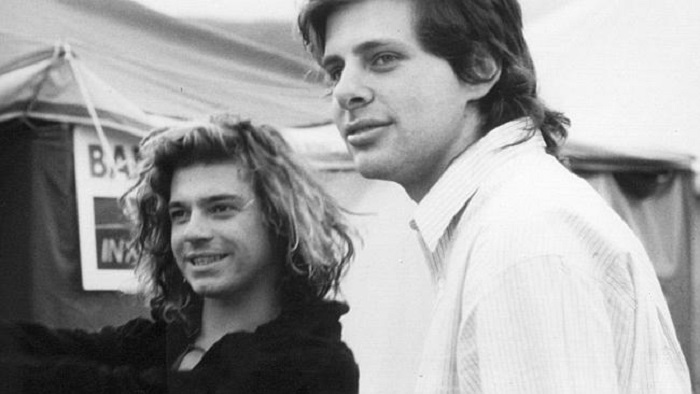
Michael Hutchence and Richard Lowenstein on the Australian Made tour.
Thirty-one years on, Dogs In Space remains as exhilarating as ever: it’s a hyper-charged, humorous and wryly captivating journey into the kinetic core of an era. Its grungy heart simmers with a cacophonous stew of punks, hippies, small triumphs and major excesses. Inspired by Lowenstein’s experiences at the forefront of Melbourne’s seventies subculture, the story loosely follows Sam (a fresh-faced Michael Hutchence, then at the height of his success with the rock band INXS, made his acting debut here) – enigmatic frontman of the titular fictional rock band – as he and girlfriend Anna (Saskia Post) abandon themselves to the kaleidoscopic chaos of his household’s incessant party. Hutchence’s lithe apparition is based on Lowenstein’s friend Sam Sejavka, who was the frontman for seventies Melbourne punk outfit The Ears.
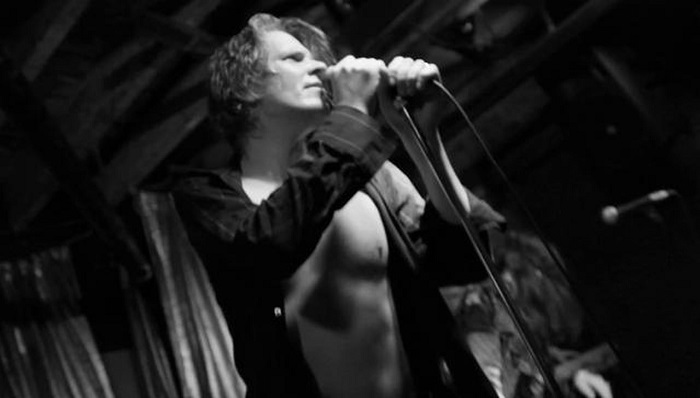
The Ears’ Sam Sejavka.
“When I was living in the house as a film student, we always joked to each other that something would make for a particularly insane scene in a film,” Lowenstein recalls. “Sam loved the script. I remember him rolling about on the floor laughing. In fact, we based a hell of a lot on Sam’s diaries and absurdist humour. That said, the script was written from a variety of improvisations and interviews that I got from a range of different perspectives. I ended up meeting a lot of people and taping their stories about early punkdom in Melbourne. It was a bit of a Rashomon-type story really. I was a real fan of Robert Altman’s work. Dogs In Space is very much a homage to that style. I was trying to create a sense of being in the house with these people, with everyone talking over the top of each other, where the most common stories in life are not about cops-and-robbers, but rather the little human stories of life and death.”
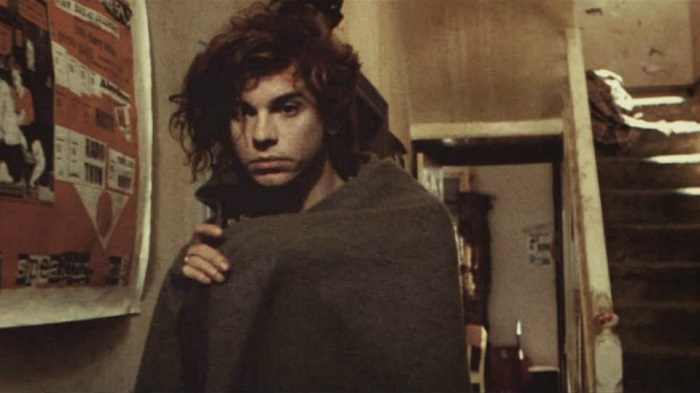
Michael Hutchence in Dogs In Space.
While breathing a striking immediacy into the film, the alchemy between fact and cinematic fiction also produced challenges, particularly when it came to the slow-burn of tragedy that closes the film. “It was always a delicate thing dramatising the tragedy at the end,” says Lowenstein. “It was only afterwards that Sam realised the perspective of it, and that it appeared as though he was an experienced drug user getting this poor girl involved in heroin. There were problems for a few years after that. At the time, he wasn’t really aware of the difference between a fictionalised cinema-reality and actual reality. He thought that we were making a blow-by-blow account of him and his girlfriend Christine [Anna in the film], but I wasn’t. I was creating a fictionalised version that [actress] Saskia Post inhabited and took over. The cautionary tale that I was telling was about the death of innocence, whereas in real life, that’s not necessarily how it happened. It was a bit more complicated than that. In hindsight, Sam has mellowed, and I think that he realises the difference between documentary and heightened cinematic realism. If you look at the film now, it’s a fantasised version of the late seventies. We didn’t actually dress like that or look like that. It captured the spirit, but it’s no piece of social realism.”
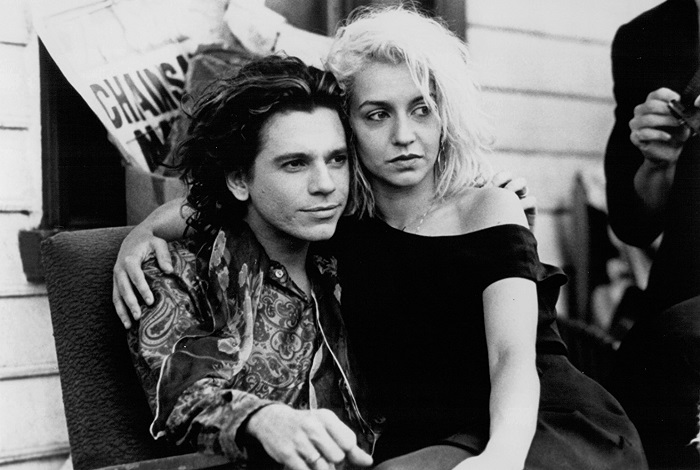
Michael Hutchence and Saskia Post in Dogs In Space.
While the germ of the film had been percolating in Lowenstein’s mind for some time, it wasn’t until one inspired moment at The Cannes Film Festival that it took shape. Lowenstein had already directed a number of early INXS film clips, during which he and Michael Hutchence had established a strong rapport. The rest fell into place. “I was in Cannes promoting [my debut feature film] Strikebound, and by pure coincidence, INXS were playing in Nice. Invariably, I dragged a bunch of Australians to the show, and afterwards we stayed up all night. I had a meeting with a producer in the morning – Michael hadn’t slept, but he came along. I was pitching an idea for a political thriller, and I could see the producer getting bored. So I said, ‘We’ve also got another project about a house full of hippies and punks living together, and Michael’s playing the lead.’ Michael looked up. ‘I am?’ he said. It was one of those spurious moments. Instantly the producer snapped awake, but I literally hadn’t written a word! Funnily enough, I remember, as a devoted fan, watching The Ears play at The Crystal Ballroom in 1979. Some friends came down from the upstairs Ballroom saying, ‘There’s someone up on stage imitating Sam!’ It was a very early INXS playing upstairs, while The Ears played downstairs. INXS were from Sydney, so we sneered at them, but that similarity was always there.”
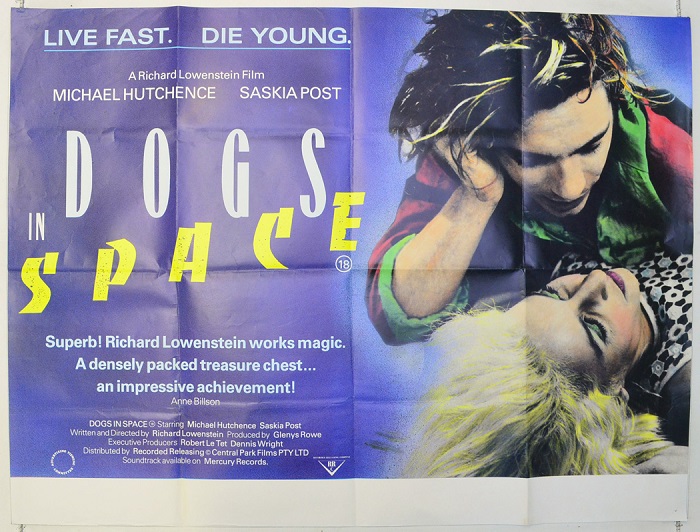
An original Dogs In Space poster.
Many of the other cast members were drawn from the sub-quarters of the punk scene, and production gradually became a hotpot of melting worlds. Lowenstein looks back on the resultant chaos of the shoot with a mixture of wonder and hindsight. “There are things that I might have done differently,” the director muses. “It wasn’t what you’d call the smoothest production. One of the biggest problems was the discipline of the punks! They’d listen to me, but they’d just laugh at the first assistant director, who they regarded as a bit of an ocker. There were incessant meetings about how we could control not only the actors, but the extras too. The punk ethos is about telling authority to fuck off, and a film crew is traditionally based on authority. Meanwhile, I had people in costume playing my best friends, and in some cases, the real people were working on my crew and were dressed in the same clothes as the actors in front of them. It was pretty chaotic, but it was also pretty funny.”

Hutch makes the cover of Cinema Papers.
The house used in the film was also the actual residence where Lowenstein had lived. “I was very determined,” the director explains. “I had the sketches and shots planned out. I wasn’t making life easy for my producers, but [producer] Glenys Rowe did an amazing job. She put the owners in a hotel for three months while we ‘de-renovated’ the house. We had a shooting budget of about $1.5 million. This wasn’t a lot for what we were trying to do with 35mm and hundreds of extras in costume. There was also a lot of pressure from the executive producers and INXS’ management. We were offered five million dollars to make INXS the main band in the film. It was tempting, but also laughable. Music was a big part of the film. This wasn’t just a bunch of punks – we had to hear and see what they were playing [from Iggy Pop and Brian Eno to Primitive Calculators and Gang Of Four]. That music summed up what our lives were. I had to create that feeling of music coming out of bedrooms.”
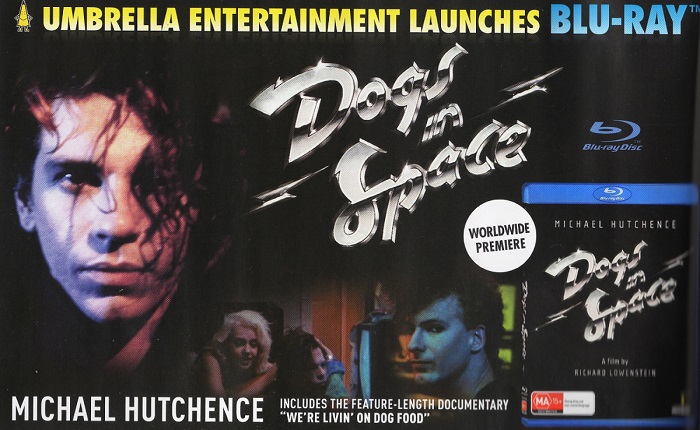
Publicity for the Dogs In Space Blu-ray release.
After Lowenstein’s work to make sure that the film would receive a big release, hopes were high. But to everyone’s surprise, the Censorship Board slapped the film with an R-rating, severely limiting the number of cinemas in which it could screen. “It came down to one person on the board,” Lowenstein explains. “We’ve literally been trying to repeal that for 25 years. It only got repealed when we rated the film again for the DVD release. Even five years before that, I offered to cut it for them. I said, ‘Tell me what offends you and I’ll cut it out.’ They sent back a letter, which I’ve still got somewhere, saying that the degenerative atmosphere pervades every frame of the film. It was hard to believe that this came out of 1986 Australia…but it did.”
Dogs In Space is available now on DVD and Blu-ray.





